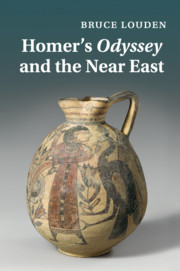Book contents
- Frontmatter
- Contents
- Acknowledgements
- Introduction
- 1 Divine councils and apocalyptic myth
- 2 Theoxeny
- 3 Romance
- 4 Odyssey 4
- 5 Odyssey 5
- 6 Odyssey 6–8, 10–12, 13.1–187; Genesis 28–33; Argonautic myth
- 7 Odysseus and Jonah
- 8 The combat myth
- 9 Catabasis, consultation, and the vision
- 10 Thrinakia and Exodus 32: Odysseus and Moses
- 11 The suitors and the depiction of impious men in wisdom literature
- 12 Odysseus and Jesus
- 13 Contained apocalypse
- Conclusion
- Bibliography
- Index locorum
- Subject index
11 - The suitors and the depiction of impious men in wisdom literature
Published online by Cambridge University Press: 04 February 2011
- Frontmatter
- Contents
- Acknowledgements
- Introduction
- 1 Divine councils and apocalyptic myth
- 2 Theoxeny
- 3 Romance
- 4 Odyssey 4
- 5 Odyssey 5
- 6 Odyssey 6–8, 10–12, 13.1–187; Genesis 28–33; Argonautic myth
- 7 Odysseus and Jonah
- 8 The combat myth
- 9 Catabasis, consultation, and the vision
- 10 Thrinakia and Exodus 32: Odysseus and Moses
- 11 The suitors and the depiction of impious men in wisdom literature
- 12 Odysseus and Jesus
- 13 Contained apocalypse
- Conclusion
- Bibliography
- Index locorum
- Subject index
Summary
After Odysseus' narration of his wanderings concludes with the events at Thrinakia, the principal narrator describes his return to Ithaka (discussed in Chapter 13). Once he has returned, the principal focus of the Odyssey becomes, directly or indirectly, the destruction of the suitors. As our analysis of negative theoxeny in Chapter 2 demonstrates, the suitors have already brought death upon themselves by offending the disguised Athena (Od. 1.227–9), provoking her divine wrath in violating hospitality. Once a disguised Odysseus is among them, the Odyssey continues to depict their failings not only through the lens of theoxeny, but through other forms of misconduct. Zeus' assertion in the opening divine council, that mortals bring suffering upon themselves through their own recklessness, establishes the Odyssey's concern with depicting relevant forms of inappropriate behavior.
His paradigmatic example of such behavior is Aigisthos' transgression of a divine interdiction. Hermes had told him not to marry Klytaimnestra, and not to kill Agamemnon (Od. 1.39). Aigisthos embodies a traditional type of immoral behavior common in Old Testament myth, the mortal who does not fear the gods. The suitors, by violating hospitality in Athena's presence, replicate Aigisthos' stance toward the gods, as do the crew when they transgress the divine interdiction on Thrinakia. But the Odyssey's favored form of recklessness is depicted in mortals who perish because of excessive or inappropriate consumption. In these ways the Odyssey resembles depictions of wicked mortals found in ancient Near Eastern wisdom literature.
- Type
- Chapter
- Information
- Homer's Odyssey and the Near East , pp. 244 - 257Publisher: Cambridge University PressPrint publication year: 2011



